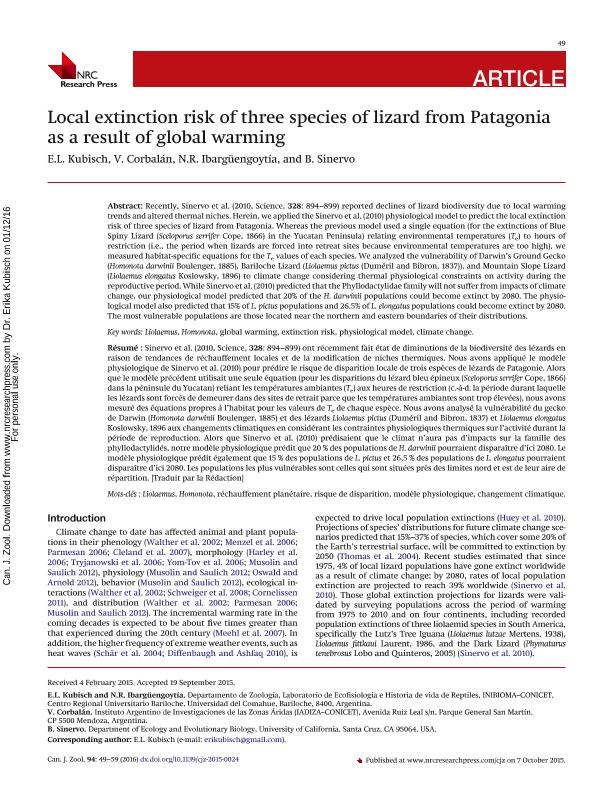Mostrar el registro sencillo del ítem
dc.contributor.author
Kubisch, Erika Leticia

dc.contributor.author
Corbalán, Valeria Elizabeth

dc.contributor.author
Ibarguengoytía, Nora

dc.contributor.author
Sinervo, Barry Raymond

dc.date.available
2018-09-27T14:22:16Z
dc.date.issued
2015-10
dc.identifier.citation
Kubisch, Erika Leticia; Corbalán, Valeria Elizabeth; Ibarguengoytía, Nora; Sinervo, Barry Raymond; Local extinction risk of three species of lizard from Patagonia as a result of global warming; National Research Council Canada-NRC Research Press; Canadian Journal of Zoology; 94; 1; 10-2015; 49-59
dc.identifier.issn
0008-4301
dc.identifier.uri
http://hdl.handle.net/11336/61020
dc.description.abstract
Recently, Sinervo et al. (2010, Science, 328: 894–899) reported declines of lizard biodiversity due to local warming trends and altered thermal niches. Herein, we applied the Sinervo et al. (2010) physiological model to predict the local extinction risk of three species of lizard from Patagonia. Whereas the previous model used a single equation (for the extinctions of Blue Spiny Lizard (Sceloporus serrifer Cope, 1866) in the Yucatan Peninsula) relating environmental temperatures (Te) to hours of restriction (i.e., the period when lizards are forced into retreat sites because environmental temperatures are too high), we measured habitat-specific equations for the Te values of each species. We analyzed the vulnerability of Darwin’s Ground Gecko (Homonota darwinii Boulenger, 1885), Bariloche Lizard (Liolaemus pictus (Duméril and Bibron, 1837)), and Mountain Slope Lizard (Liolaemus elongatus Koslowsky, 1896) to climate change considering thermal physiological constraints on activity during the reproductive period. While Sinervo et al. (2010) predicted that the Phyllodactylidae family will not suffer from impacts of climate change, our physiological model predicted that 20% of the H. darwinii populations could become extinct by 2080. The physiological model also predicted that 15% of L. pictus populations and 26.5% of L. elongatus populations could become extinct by 2080. The most vulnerable populations are those located near the northern and eastern boundaries of their distributions.
dc.format
application/pdf
dc.language.iso
eng
dc.publisher
National Research Council Canada-NRC Research Press

dc.rights
info:eu-repo/semantics/openAccess
dc.rights.uri
https://creativecommons.org/licenses/by-nc-sa/2.5/ar/
dc.subject
CLIMATE CHANGE
dc.subject
EXTINCTION RISK
dc.subject
GLOBAL WARMING
dc.subject
HOMONOTA
dc.subject
LIOLAEMUS
dc.subject
PHYSIOLOGICAL MODEL
dc.subject.classification
Otras Ciencias Biológicas

dc.subject.classification
Ciencias Biológicas

dc.subject.classification
CIENCIAS NATURALES Y EXACTAS

dc.title
Local extinction risk of three species of lizard from Patagonia as a result of global warming
dc.type
info:eu-repo/semantics/article
dc.type
info:ar-repo/semantics/artículo
dc.type
info:eu-repo/semantics/publishedVersion
dc.date.updated
2018-09-24T13:54:22Z
dc.journal.volume
94
dc.journal.number
1
dc.journal.pagination
49-59
dc.journal.pais
Canadá

dc.journal.ciudad
Otawa
dc.description.fil
Fil: Kubisch, Erika Leticia. Consejo Nacional de Investigaciones Científicas y Técnicas. Centro Científico Tecnológico Conicet - Patagonia Norte. Instituto de Investigaciones en Biodiversidad y Medioambiente. Universidad Nacional del Comahue. Centro Regional Universidad Bariloche. Instituto de Investigaciones en Biodiversidad y Medioambiente; Argentina
dc.description.fil
Fil: Corbalán, Valeria Elizabeth. Consejo Nacional de Investigaciones Científicas y Técnicas. Centro Científico Tecnológico Conicet - Mendoza. Instituto Argentino de Investigaciones de las Zonas Áridas. Provincia de Mendoza. Instituto Argentino de Investigaciones de las Zonas Áridas. Universidad Nacional de Cuyo. Instituto Argentino de Investigaciones de las Zonas Áridas; Argentina
dc.description.fil
Fil: Ibarguengoytía, Nora. Consejo Nacional de Investigaciones Científicas y Técnicas. Centro Científico Tecnológico Conicet - Patagonia Norte. Instituto de Investigaciones en Biodiversidad y Medioambiente. Universidad Nacional del Comahue. Centro Regional Universidad Bariloche. Instituto de Investigaciones en Biodiversidad y Medioambiente; Argentina
dc.description.fil
Fil: Sinervo, Barry Raymond. University of California; Estados Unidos
dc.journal.title
Canadian Journal of Zoology

dc.relation.alternativeid
info:eu-repo/semantics/altIdentifier/doi/https://dx.doi.org/10.1139/cjz-2015-0024
dc.relation.alternativeid
info:eu-repo/semantics/altIdentifier/url/http://www.nrcresearchpress.com/doi/10.1139/cjz-2015-0024
Archivos asociados
